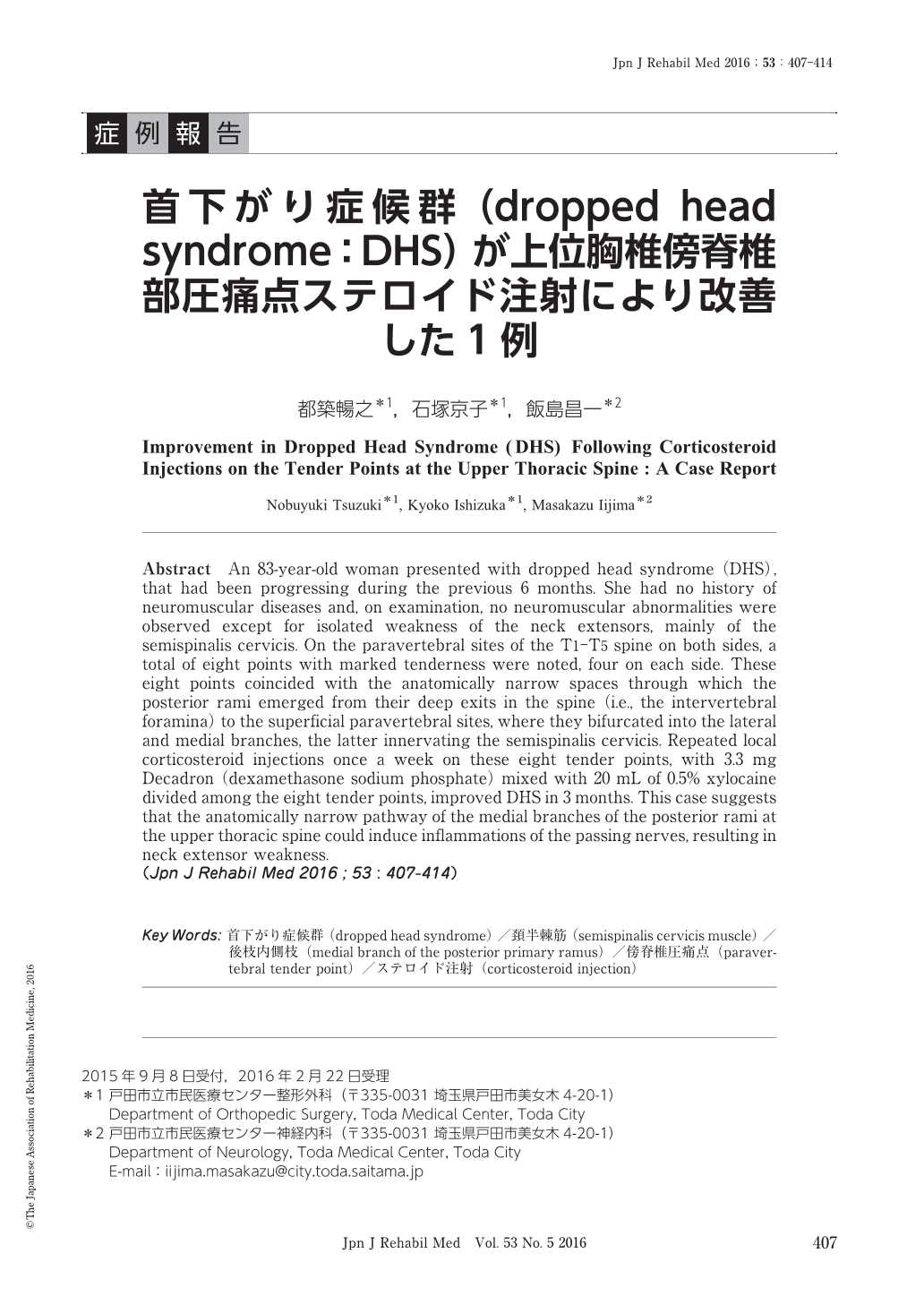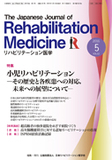Japanese
English
- 販売していません
- Abstract 文献概要
- 1ページ目 Look Inside
- 参考文献 Reference
はじめに
首下がり症候は1800年代から報告があり,全身的な神経・筋疾患,内分泌疾患などの基礎疾患に伴う二次的なものと,原因疾患が不明な特発的なものが存在する1, 2).
頚部筋の筋力および緊張度に関しては,頚椎後方筋(後頚部筋)が筋力低下を示す場合と,頚椎前方筋(特に屈筋)が過緊張を示す場合がある.全身的疾患では,前者は多発筋炎や重症筋無力症,顔面肩甲上腕型筋ジストロフィー,筋萎縮性側索硬化症などで認められ,後者はパーキンソン病とパーキンソン症候群を特徴とする多系統萎縮症で認められている3, 4).
後頚部筋の筋力低下による首下がり症候群(dropped head syndrome,以下DHS)の特徴は,罹患筋が頭頚部伸展筋群のすべてではなく,主作用筋のみの脱力でも発生し得ること,それが両側対称性であること,また胸椎後弯度が増大すれば頚椎の前傾傾向が生じ,頭部重量のため頚部重心が脊柱軸より前方にずれやすく,垂直位での首下がり現象を増大させることである.
全身的神経・筋疾患に伴わない局所的な頚部伸展筋の筋力低下の存在については,1986年にLangeら5)が,the floppy head syndromeとして報告した頚部伸展筋筋力低下を呈する12例のうち4例が筋生検を行っても病因を特定できず,3〜5年間不変であったと報告した.さらに1992年にSuarezら6)が,1996年にKatzら7)がそれぞれ長期経過後も局所的首下がり症状のみを呈する4症例を分析し,筋病理および筋電図所見により全身性神経・筋疾患,頚髄疾患から鑑別可能な独立した疾患単位であるとした.観察期間は,Suarezらは5〜8カ月,Katzらは6〜54カ月である.両者はともに症状確立期における筋病理所見として非炎症性の非特異的筋線維変性と結合組織増生を,筋電図所見としてfibrillation,positive sharp waveなどを伴い初期recruitmentを示すshort duration motor unit potentialsを報告している.薬物療法として,Suarezらは4例中1例にステロイドを,Katzらは4例中3例に臭化pyridostigmineとステロイドを投与しているが,いずれも改善効果は得られていない.これらの病態を示す症候群をSuarezらはDHSと命名したが,Katzらはisolated neck extensor myopathy(以下,INEM)と呼び,INEMが病態の特殊性をあらわす名称として適切であるとした.その後,筋病理に関して,石口ら8)は慢性炎症性変化を示した2例を報告している.薬物治療に関しては,最近,Muppidiら9)は免疫抑制剤が,Larsenら10)はステロイドが有効であったと報告している.
このほかに薄ら11)は頚椎症に伴う頭・頚半棘筋の脱力の原因として頚椎症性のC5,C6髄節・神経根性障害の可能性を指摘し,Xiaolongら12)は青年期の長時間・習慣的頚椎前屈が青年期特発性頚椎後弯(adolescent idiopathic cervical kyphosis)の誘因になるのではないかと報告している.またOerlemans13)はDHSとbent spine syndromeはともに全脊柱筋を主に侵す“primary tardive myopathic condition”に属するものではないかと述べている.
過去の論文を通じて,DHSにおける神経・筋系の病変発生部位に関する検討は,中枢神経,脊椎,脊髄細胞〜神経根および筋について行われているが,神経根よりさらに末梢の筋支配神経枝については検討されていない.
われわれは83歳女性で亜急性にDHSが発生した症例において,両側頚半棘筋の筋力低下と,上位胸椎の両側傍脊椎部に高度の圧痛点の存在を認めた.これらの所見の解釈として,上位胸椎の傍脊柱部に存在する頚半棘筋の筋支配枝(後枝内側枝)の通過点に炎症が生じ,筋支配枝の炎症性神経伝導障害により,頚半棘筋の筋力が低下したのではないかと考えた.炎症治療の目的で圧痛部にステロイド併用ブロックを行ったところ,約3カ月の比較的短期間にDHSが改善した.この末梢病理は,DHS発現に共通する局所的発生要因の1つとなる可能性があり,治療経過を報告するとともに病因発生機序を考察する.
An 83-year-old woman presented with dropped head syndrome (DHS), that had been progressing during the previous 6 months. She had no history of neuromuscular diseases and, on examination, no neuromuscular abnormalities were observed except for isolated weakness of the neck extensors, mainly of the semispinalis cervicis. On the paravertebral sites of the T1-T5 spine on both sides, a total of eight points with marked tenderness were noted, four on each side. These eight points coincided with the anatomically narrow spaces through which the posterior rami emerged from their deep exits in the spine (i.e., the intervertebral foramina) to the superficial paravertebral sites, where they bifurcated into the lateral and medial branches, the latter innervating the semispinalis cervicis. Repeated local corticosteroid injections once a week on these eight tender points, with 3.3 mg Decadron (dexamethasone sodium phosphate) mixed with 20 mL of 0.5% xylocaine divided among the eight tender points, improved DHS in 3 months. This case suggests that the anatomically narrow pathway of the medial branches of the posterior rami at the upper thoracic spine could induce inflammations of the passing nerves, resulting in neck extensor weakness.

Copyright © 2016, The Japanese Association of Rehabilitation Medicine. All rights reserved.


